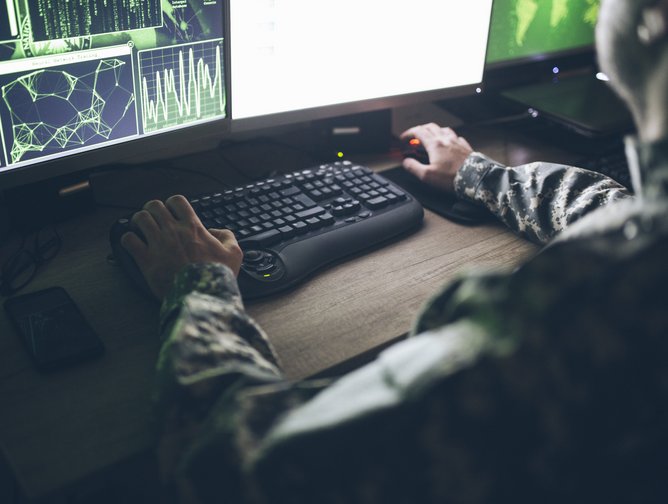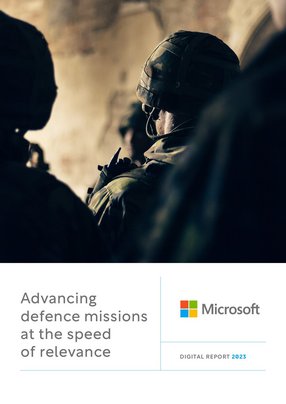Microsoft has been a technology leader supporting the allied defence ecosystem for four decades. They have been a key partner helping organisations around the globe to harness data as an asset and deliver technology solutions to accomplish mission-critical outcomes.
As the technological landscape continues to evolve, developments are now coming faster than ever. As Kate Maxwell, Chief Technology Officer for Microsoft’s Worldwide Defence and Intelligence Industry, explains, the rate of advancements – particularly in recent years – has been extraordinary.
“Our defence customers face adversaries who are increasingly taking an integrated offensive posture – with traditional kinetic effects now married with cyber effectors and disinformation campaigns,” she says.
“That is modern warfare, and it is playing out in real-time.”
Modern warfare
Traditionally, warfare has primarily involved the deployment of military forces, the use of conventional weapons, and strategic manoeuvres in the domains of ground, sea, air, and space. However, given rapid advancements in technology and the ever-growing proliferation of data, the dynamics of conflict are shifting. The convergence of compute capabilities, communications infrastructure, and sophisticated cyber effects has opened up a new realm of warfare in the information domain.
Today, as Maxwell elucidates, this new landscape is playing out in real-time: with the ongoing conflict in Ukraine a notable example of the world’s first “broadband war.”
“Defence and Intelligence leaders have been predicting this moment for a long time. This is what modern warfare looks like - where you have cyber and disinformation campaigns leveraged in concert with kinetic effects,” she says. “We are seeing this play out in Ukraine today, right this very moment. And this did not come as a surprise.
“At Microsoft, we help governments and defence organisations find digital refuge in the hyperscale cloud, and Ukraine did a fantastic job of using the cloud to secure their digital defences and keep citizen services up and running. – even as Russia launched their offensive campaign. I am proud of the way that Microsoft – and the broader tech ecosystem – has stepped up to support Ukraine. Those efforts have made an impact, particularly on the cyber, comms, and information front.”
As Maxwell describes, Microsoft works with defence and intelligence clients not only in the mission space, but also with back-office defence processes. From workforce skilling and smart facilities to the provision of data-driven analysis, improving organisational readiness posture is essential.
“When we're talking about modernisation in the defence space, everybody starts with a mission, because that's the more exciting part. But how do we help defence organisations modernise their “back office” processes and empower their personnel? How do we help them speed up time to value, realise rapid innovation, and modernise the capability lifecycle through DevSecOps and Digital Engineering? How do we help defence organisations achieve data-driven postures so they can harness their data as an asset and elevate it to insights? How do we help them secure and modernise the defence worker experience to reduce daily pain-points?
These are many of the initiatives we spend our time talking about and, hopefully, inspiring our customers to go do, because the world is changing around them, and they have to keep up. It’s not just about mission – it is about a whole-of-enterprise transformation,” Maxwell states.
“The way you maintain superiority is through digital transformation, culture & process reform, and rapid adoption of commercial technology.”
Maxwell points to a quote from US Gen Charles “CQ” Brown Jr. to illustrate the urgency of this need: “Accelerate change or lose.”

The power of AI
The acceleration in artificial intelligence (AI) advancement has been dramatic in recent years, with impacts being felt across all industries. The defence industry is no exception.
“In terms of AI capability, there has never been a bigger time than this. I’ve been working in tech for two decades now, and I have not seen an inflection point like the one we're sitting at today,” Maxwell comments.
“For a lot of folks, it feels like generative AI popped up overnight, but this is the result of decades-worth of work to get to this point. This is a remarkable time in compute, AI advancement, and the democratisation of some seriously game-changing capabilities. And I really believe this is only the beginning.”
Across a range of use cases, AI can be used to drive efficiencies and provide defence organisations with a competitive edge. A popular term in modern defence organisations, the “OODA loop” involves four steps: to observe, orient, decide, and act. AI, when used properly, can be harnessed to augment and accelerate that process, particularly when considering the massive amounts of data available to any modern defence force.
“What we're trying to do is help our customers figure out how to use AI to speed up that OODA loop. We talk to our customers about capabilities like predictive maintenance for an informed readiness posture; about modelling and simulation of threats, and of the operational environment itself; for mission planning; for speech and text translation – especially when they're working with allies who may not have the same native tongue; and multi-intelligence (INT) fusion and processing for situational awareness.
“All of these use cases touch the OODA loop in some way, and all of them can be informed and augmented by AI. And I’m not even talking about generative AI - all of these can be accomplished with baseline ‘flavours’ of artificial intelligence – or even data analytics, much of which has already been around for years.”
From there, organisations can begin to utilise more advanced techniques, including generative AI – with capabilities including content generation, summarization and information discovery, code generation, and semantic search.
“With generative AI, the aperture has widened in terms of AI capability and opportunity. We are talking to defence organisations and the defence industrial base (DIB) about how to leverage these capabilities to support the mission, as well as to improve operations in their own enterprises.
For example, code generation: there are hundreds of thousands of software developers supporting the allied defence ecosystem, writing millions of lines of code each year. Can we use generative AI to help increase their speed and effectiveness – such as with Copilot for GitHub, as an example? That, in turn, would result in faster time-to-value to get capabilities in the hands of the warfighter. ‘Innovation at the speed of relevance,’ as we say in defence. That’s what it’s all about.”
Another example, as Maxwell explains, is AI-enabled cybersecurity and cyber threat hunting. “In Ukraine, Microsoft’s Defender for Endpoint used an AI algorithm to identify Russian wiper malware and stop it from being installed in the customer’s network. We are now bringing these AI-enabled cybersecurity capabilities to our customers all over the globe with our Microsoft Security Copilot, which uses AI to help defenders identify and respond to threats more quickly. Not only will this create efficiencies and speed up response times in cybersecurity incidents, but it will also help address the critical talent gap that exists in the global cybersecurity landscape.”
Though AI presents a swathe of opportunities for every industry, including defence and intelligence, it also presents some very real challenges and threats.
“We are already seeing adversarial nations leveraging AI to great effect in some cases, and those adversaries don't hold themselves to the same standards, ethics and principles as allied nations,” she says. “The defence ecosystem has to figure out how to strike the right balance between rapidly adopting and leveraging these commercial technologies for good, while also taking a thoughtful, principled, and responsible approach – and keeping in mind that adversaries are not slowing down one bit.”
The role of culture reform and bureaucratic courage
Maxwell is keen to reiterate that the success of the allied defence ecosystem hinges on more than just technology. “The next great power competition will likely be won or lost based on the speed at which new tech can be developed AND adopted - including capabilities like cloud, cybersecurity and AI, and a focus on more software-centric capability going forward.”
She adds: “This is not a technology development race; it is a technology adoption race, and to be successful, we have to get defence culture right. This requires bureaucratic courage – to cut through red tape and transform legacy processes in a way that aligns with the transformation defence organisations are trying to drive.”
Maxwell goes on to explain that the defence ecosystem also needs to take a realistic assessment of where it is today, and then put the proper process and cultural underpinnings in place to enable the adoption of modern technologies.
“When we're talking about advanced capabilities like artificial intelligence, we want to inspire our customers to think big, and we also want to ground ourselves in reality. Organisations have to crawl and walk before they can run – and we can help them through that entire journey.”
So with that in mind, defence organisations endeavouring to leverage these commercial technologies should consider a few things: “Do you have a good handle on your data estate? Think about what data is available to you; where that data lives; how that data is classified, secured, and controlled; and most importantly, what you want to do with it. What are your goals and objectives for elevating that data to insights?”
A first step in that journey is the move to hyperscale cloud – which doesn’t need to happen all at once. Maxwell recommends starting with the small, “easy button” workloads and use cases to gain successes and momentum, to learn important lessons, and then to scale and grow.
Organisations also have to get the right culture in place to support the transformation they are trying to drive. “I think the defence ecosystem at large is still very risk averse. That is for good reason, I understand – both in terms of safety, and for contracting rigour. But many times, the defence ecosystem is trading one risk for another without even realising it. This level of risk aversion has led to a very policy heavy, rigid environment in which it is challenging – if not impossible – to innovate, and it also makes it challenging to attract non-traditional vendors and new entrants who could bring real value to mission. This is a big challenge, and it is holding the allied defence ecosystem back. This ecosystem has to empower folks to do differently. We have to make sure people have the psychological safety to go try new things, and to fail forward in a growth-oriented and empowering environment.
Microsoft is here to help its customers with these cultural transformations, just as much as the technology transformations. “We're a tech company, but more than that, we're a mission partner, and that means we cover everything – including people and skilling, process and policy, and modernization of how an organisation does business – because it all matters,” Maxwell describes. “If any one of those pillars should fail, the entire transformation is at risk. These are foundational elements, and the defence ecosystem needs to get them right.”

Accelerate change or lose
When it comes to implementing change, there are a number of barriers to adoption, such as policy, process, acquisitions, skilling and trust.
Acquisition processes for military and defence are a great example of the transformation needing to happen in all areas – beyond just the tech. From a historical perspective, defence procurement methods were set up to support the years and decades-long procurement of large, monolithic hardware platforms. But, when it comes to the fast-paced world of software, that procurement system has serious limitations.
“If you want to go buy a ship or a tank or an aeroplane and you have all your requirements defined up front, then perfect. The acquisition system works for that,” Maxwell says.
“But where that system struggles is in the procurement of capability where the requirements are not as well understood, or are evolving in real time - which often includes software. It is really challenging for our defence customers to go buy commercial technology and software-centric capabilities with legacy acquisition methods that were set up to buy giant, monolithic, well-defined pieces of hardware.”
As a result, Microsoft is working to advise defence customers on how to transform their processes to support the digital transformation they are trying to drive; therefore, enabling them to obtain the commercial technology and software innovation that is proving essential in modern conflicts – while helping customers remain compliant with their own processes.
Maxwell points back to the General CQ Brown quote: "Accelerate change or lose."
“The defence ecosystem has to accelerate change, and this is not just a technology story,” she comments. “This is about how we change the ecosystem itself, including acquisition, including skilling, including policy, so that customers can access and adopt the right kind of capabilities at the time and place of need. Speed-to-field and speed of adoption are mission-critical.”
Leveraging such commercially-facing capabilities was critical for Ukraine, particularly in the early stages of the war, Maxwell explains. “The first shots fired by Russia were not kinetic; they were cyber weapons and disinformation campaigns.
“Russia very intentionally began launching targeted cyber effectors and disinformation campaigns at the Ukrainian government, people, and infrastructure well before the kineticcampaign began. Ukraine quickly mobilised in digital fashion and changed their policies overnight to move critical data and essential services into the hyperscale cloud. That's what refuge in the digital realm looks like, and it is working.
“So, what we advise our Public Sector customers to do is not wait until it's an emergency. Don't wait until you are forced to hit the red emergency button in wartime. Start getting your data estate and your cloud adoption journey in shape today, so you can take advantage of commercial innovation and not have to seek digital refuge under duress. It should not require an emergency to kickstart a move to the cloud. Make the move today, so you can begin taking advantage of all of the goodness afforded by a modern digital posture – and you’ll enjoy a much stronger cybersecurity posture as a result.
“At the end of the day, this is not just a technology development race. It's a technology adoption race, and the biggest barriers to that are policy, process, acquisitions, skilling, and culture. These barriers can be overcome, and the allied defence ecosystem needs to treat this with urgency.”
Industry trends
With so much experience in the defence and intelligence industry, and with the explosive growth in dual-use, software and IT-centric mission capability, Microsoft will continue to help its customers navigate this changing global landscape.
“The world continues to change around us, and around our customers,” Maxwell says. “We will continue to support our allied defence customers as a mission partner. We are committed, and we are staying the course.
“Defence and Intelligence is a priority industry for Microsoft, and has been for a long time. I'm really proud of that, and quite frankly, it’s what brought me here. As a company, we have made a commitment to support democratically-elected institutions around the world. This is how we help make the world a better, safer place, and deliver on our mission: to empower every person and every organisation on the planet to achieve more.
At such an exciting time in the technology world, what are the trends to look out for, we ask?
“What an incredible time to work in technology – and honestly, every organisation and every company on the planet is now a tech company. There are a lot of technology trends shaping the future of defence right now, and I think many of these will be around for a long time to come,” Maxwell predicts.
“Cloud, I'm convinced, is here to stay. This is what the future of compute looks like, and it serves as the secure foundation for so many other capabilities – AI in particular.”
Networking and communications mediums such as 5G, 6G, and space-based comms are also proving vital in a defence context: “When working in defence, you have to support tactical scenarios where connectivity is not always guaranteed. We can't assume there's going to be fibre at a deployed site in some far-flung theatre. So we are constantly working to mature the cloud continuum – from cloud to edge – and leverage the fullness of the spectrum to provide secure access to data and communications even in the most harsh and remote environments on – or off – the planet.
“That includes 5G and 6G, and it also includes all things space. Space and satellite-based communications continue to be critically important – particularly at the edge.”
Modelling & simulation, digital engineering, digital twin, and DevSecOps will also continue to be important, particularly for capability lifecycle modernization, and to speed-up time-to-value for critically important mission innovations.
Maxwell also mentions the importance of quantum, and the expected impact of this emerging area in the years ahead: “Quantum is another trend that I expect will be huge, especially from a national security perspective. With the rise of quantum compute at scale, we're going to see some changing national security postures. I think it's going to do great things for a number of defence use cases - secure communications, for instance, as well as some interesting intelligence applications. On the flip side, quantum poses some very real challenges, particularly when we're talking about traditional encryption methods and cryptography within the national security realm.
“So, that’s my short list of trends, and I want to point out that the vast majority of these are software-defined and underpinned by the cloud. So that's why we at Microsoft are continuing to counsel defence customers that it's time to modernise. So for any defence organisations out there who have not yet started on that journey, today is a great day to begin, and we're here to help.”



